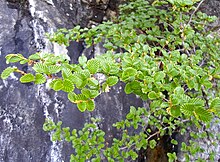User:Jbbotany/sandbox
| This is not a Wikipedia article: It is an individual user's work-in-progress page, and may be incomplete and/or unreliable. For guidance on developing this draft, see Wikipedia:So you made a userspace draft. Find sources: Google (books · news · scholar · free images · WP refs) · FENS · JSTOR · TWL |
| Nothofagus gunnii | |
|---|---|

| |
| Scientific classification | |
| Kingdom: | |
| (unranked): | |
| (unranked): | |
| (unranked): | |
| Order: | |
| Family: | |
| Genus: | |
| Species: | N. gunnii
|
| Binomial name | |
| Nothofagus gunnii (Hook.) Oerst.
| |
Nothofagus gunnii is a deciduous shrub/small tree endemic to Tasmania, Australia, and the country’s only native temperate winter-deciduous tree.[1] It is commonly known as the Deciduous Beech for this reason, or alternatively Tanglefoot because of its growth habit in exposed areas with twisted, ground hugging branches in a dense shrub. [2]
Morphology[edit]
Growth habit[edit]
Nothofagus gunnii grows as a small tree 1.5m to 5m high (depending on the severity of the conditions) in sub-alpine regions[3] [4], but as a prostrate shrub, sprawling over boulders in alpine heathlands [5]. In exposed areas it can grow as a wiry tangled shrub to 2.5m, forming impenetrable stands [6] – the growth rate of these stands is very slow.[7]
Leaves[edit]
Nothofagus gunnii has light green leaves, turning yellow, orange and red through autumn.[8] The leaves are small, with a lamina 10 – 20mm long [4], and alternate, with round teeth and veins that lead to the gaps between the teeth.[9]
Flowers and fruits[edit]
The Nothofagus gunnii flowers are small, and flower in December. The male inflorescence has 1-3 flowers and pendant stamens. The female inflorescence is 3-5mm long and egg-shaped, with 3 flowers and protruding styles, and wind pollenated. The fruit are small nuts in woody fruits and are 8mm long, with 4 valves made up of overlapping scales.[4][3]
Distribution[edit]
There is a total of less than 10000 hectares of Nothofagus gunnii growing in the whole of Tasmania[2], predominantly around Mt. Field and Cradle Mountain in the west of the state.[7] It grows in alpine heathlands and sub-alpine rainforest, and rarely below 800m [10], since it requires a very cold winter and 1800mm of rain each year.[7]
Advantages and Adaptions[edit]
As the only winter-deciduous tree in Tasmania, in really cold winters, Nothofagus gunnii has a competitive advantage over other plants such as Nothofagus cunninghamii at high altitudes. This is because the leaves do not need to be protected against the environment or predators in the harsh winter conditions.[1]
In growing months, the leaves have higher amounts of nutrients than N. cunninghamii.[1] In autumn, the chlorophyll in the leaves breaks down and a different pigment called anthocyanin takes over, resulting in the colour change from pale green to yellow or orange. As the leaves cease to take up further nutrients, the leaves fall to the ground, recycling any minerals they contain back into the soil for the next spring’s new growth.[2] Anthocyanin also occurs in the bark of Eucalyptus coccifera, giving it its distinctive autumnal colour.
Status and Conservation[edit]
Nothofagus gunnii is very slow growing and only found in a limited area, as mentioned above. Its seeds do not do very well upon seed dispersal, surviving only a short time in the soil. They are only found within a 100m radius of the parent plant, as there is no adaption for wind dispersal.[7]
The main threat to the species is fire, penetrating the thin bark and killing the adult trees, which do not regenerate.[7] Nothofagus gunnii is very slow to grow back from a fire, and may not even recover as other plants with faster growth rates may take over.[2] The species has a high light requirement (the highest of any Nothofagus species in Australia), and therefore cannot regenerate in closed forests,[11] so it can be easily crowded out by competing species in some habitats after a fire. While the species is not listed as threatened or endangered, these factors show that care must be taken to preserve it, specifically in relation to fire hazards.
References[edit]
- ^ a b c Kohout, M. (2012) "Deciduous beech Nothofagus gunnii." Wild: Australia's Wilderness Adventure Magazine no. 128, p. 16.
- ^ a b c d Dpipwe. (2014). "Fagus - Tasmania's Botanical Wonder". Retrieved 2015-03-24.
- ^ a b Launceston Field Naturalists Club. (1981) "Guide to Flowers and Plants of Tasmania."
- ^ a b c The Atlas of Living Australia (2012). "Nothofagus gunnii."
- ^ Tng, D. (2013). "The Last Deciduous Tree". Retrieved 2015-03-24.
- ^ Hewson, H. (1989). "Flora of Australia Online". Retrieved 2015-03-24.
- ^ a b c d e Kaufman, O. (2007) "Tassie's Golden Spectacle." Australian Geographic no. 86, pp. 36-37.
- ^ Keble-Williams, P. (2012) "Canopy arthropods and herbivory on the Tasmanian southern beeches, Nothofagus cunninghamii and Nothofagus gunnii." PhD Thesis, UTas
- ^ Jordan, G. (2011). "Key to Tasmanian Vascular Plants - Nothofagus gunnii". Retrieved 2015-03-24.
- ^ Read, J. (1989) "Phenology and germination in some rainforest canopy species at Mt Field National Park, Tasmania."
- ^ Read, J. & Hill, R. (1985) "Photosynthetic Responses to Light of Australian and Chilean Species of Nothofagus and their Relevance to the Rainforest Dynamics." New Phytologist vol. 101, no. 4, pp. 731-742
gunnii Category:Fagales of Australia Category:Flora of Tasmania Category:Endemic flora of Tasmania Category:Endemic flora of Australia

